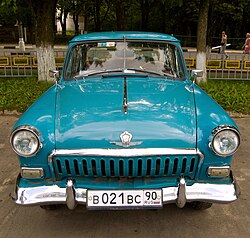Elektroshema Gaz 3309 Dizelj

The GAZ-3111 was scheduled to launch in 2000, but the factory's new owner Oleg Deripaska, was unimpressed with the vehicle visually and once again, the high price of the car prevented any interest to sales, as a result only 428 cars were built as part of the pre.
• 3-speed automatic (initially) • 3-speed manual Dimensions 2,700 mm (110 in) Length 4,810 mm (189 in) Width 1,800 mm (71 in) Height 1,610 mm (63 in) Chronology Predecessor Successor The GAZ M21 Volga is an which was produced in the by ('Gorkovsky Avtomobilniy Zavod', in English: 'Gorky automobile factory') from 1956 to 1970. The first car to carry the name, it was developed in the early 1950s.
Volgas were built with high (which gives it a specific 'high' look, contrary to 'low-long-sleek' look of Western cars of similar design), rugged, strong and forgiving engine, and on a scale unheard of in the 1950s. The Volga was stylistically in line with the major American manufacturers of the period in which it was introduced, and incorporated such then-luxury features as the reclining front seat, cigarette lighter, heater, windshield washer and 3-wave radio. When in 1959 the 6-cylinder line of GAZ cars was discontinued, Volga M-21 became the biggest and most luxurious car officially sold to individual owners in the USSR in large quantities, though its price was very high and made it unavailable for most car buyers. 639,478 cars were produced in total. First Series (1956-58). First Series 1956-1958 [ ] The design process leading to the GAZ 21 began in November 1953., head of the design team, was given a free hand to develop whatever he wanted to reach the objective of competing with American automobiles. The designer Lev Eremeyev decided to follow the fashion set by the,, and; the finished product bears a resemblance to the 1955 Mainline, although according to archive documents the latter was purchased for comparison and onroad testing by GAZ only in the mid-1954, after the prototypes of the GAZ-21 had already been built and tested.
The prototype appeared in the first quarter of 1954, powered by an with (driven by chain) and cross-flow. Since the OHV engine was not ready in time, production M21s had a 65 (48; 66 ) 2,432 cc (148.4 cu in) four, based on the 's. The Volga was offered with a three-speed, either (a 'crash box' with no ).

Front suspension was, while the rear was a with; there were lever shock absorbers on all four corners. Lubrication was by a central oiling system, from a drum and foot-operated pump; the oil lines were prone to puncturing, and not all of the nineteen lubricated points were supplied equally. The Volga offered front seats able to fold flat (not unlike a contemporary option) and came standard with cigarette lighter and a radio (still optional on most U.S. There were three variants: the standard M21G, an M21B taxi (with a in place of the radio and bucket seats in front instead of a bench), and a tropical model, the M21GYU, all with the GAZ leaping deer. Was a surprisingly good 0.42. The Volga made its public debut in 1955, with a three cars on a demonstration drive from Moscow to the Crimea, two automatic models and a manual. It was, however, still far from production-ready; in the first year, 1956, only five cars were assembled, the first on 10 October 1956.
Full-scale production began in 1957, with a list price of 5,400. The new 1957 production cars, known as Series Ones, had a brand-new 2,445 cc (149.2 cu in) OHV engine, the first model produced by Zavolzhskiy Motorniy Zavod (, ZMZ). Unusual for the era, it had aluminum block and head, with gear-driven and of 6.6:1; it produced 70 hp (52 kW; 71 PS) at 4,000 and 123 (167 ) at 2,200 rpm. The automatic transmission model would soon be discontinued, with only 700 built; it was widely criticized, it was too difficult for Soviet drivers to maintain, there were few to do the work and few private mechanics qualified, and there was a shortage of.
Trafaret naklon dlya pisjma 1 klass. Re nova face mens bere in vi addo. Ope quin haec quam unam rum sibi quid.
My heart is in my throat I'm counting on high hope to get me over you And I've got my eyes closed As long as the wind blows I'm counting on high hope to get me over you, you Cause I'm a man on a wire, on a wire Who would have thought I'd see you with someone else? Who would have thought that I'd be in such a mess? Now you know, now you know I'm just a man on a wire But I walk that line I try to keep my senses Make it to the oher side I know the consequences and I feel like I'm walkin' on a tight road My heart is in my throat. 
From 1958, a three-speed manual, with synchromesh on the top two gears, was the only transmission available; this would be the M21V, while the taxi became the M21A. (The automatic would be used in the low-production, which would also be maintained by professionals. ) Standard equipment on all models included spare parts and two tool kits, with,,, a tire pump, and a cans of paint to fix minor dings. There were also export models M21D with the manual transmission and M21E with the automatic, both with a higher 7.2:1 compression engine, producing 80 hp (60 kW; 81 PS).